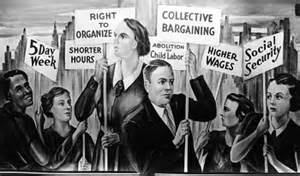From Dissent Magazine
In 2011, Wisconsin public sector workers demonstrated to fight changes to their state collective bargaining laws, and upwards of 100,000 workers assembled on the state capitol. Rightly, the workers saw this change by Governor Walker as an effort to bust unions, given that union density in the private sector had decreased to 7%, but in the public sector it is at 35%. Pitting public sector unions against the general public, in terms of pensions and benefits, continues in discussions on Detroit’s bankruptcy, and most recently by Mayor Bloomberg who blamed New York’s fiscal instability on public sector unions. The racial dimension of this general attack on public sector unions given that municipal jobs are a pathway for working class African-American families to enjoy economic stability underscores how race and class intertwine in any conversation on economic justice. Although Governor Walker was not defeated in the recall election, a county judge found that the law was unconstitutional for city and county workers. However, a federal case was brought, and there the appellate court found Act 10 constitutional as applied to state workers.
Since then, and before, we have seen the resurgence of the labor movement from various sectors including domestic workers and most recently fast food workers. For August 29, 2013, fast food workers have called for a national strike, which has been built up through a series of local actions. The national strike was called by a coalition of fast food workers, labor unions, and religious groups. Although in a non-union workforce, the invocation of the strike and call for one-day stoppages are the powerful economic tools that labor unions use, but too cautiously wield. The fast food workers strike is the type of bold organizing and creative partnerships needed to maintain labor’s revival on the national political stage.
Around the same time, AFL-CIO has been exploring ways to expand its membership and revive organizing by partnering with workers centers. They have issued charters for national worker center networks including the New York Taxi Workers Alliance and the National Domestic Workers Alliance. In its upcoming convention, AFL-CIO seeks to focus on its relationship with worker centers and other progressive civil rights and environmental organizations. This 2013 convention can provide traditional labor an opportunity to take bold positions in its relationships with worker centers, and lead a national dialogue not just on labor issues, but other issues impacting working families today. Rather than viewing the current state of labor as a “crisis”, labor movement should view it as an opportunity to make dramatic changes. Looking back at pre-NLRA organizing time period, labor organizations experienced a decline, but that lead to major worker protection, that since then business interests have been chipping away. Even prime time news stations have committed to cover labor topics. For those who have been involved with labor issues for sometime, this is an inspiring and promising shift.
At a time when consumers and the general public would see labor issues in opposition to their own, because it would increase costs to them in delivery of services, now, consumers and the general public express more sympathetic views, especially around campaigns to increase the minimum wage. For the New York Taxi Workers Alliance, I have observed a marked shift from the riding public’s view and that of elected officials of a fare increase to drivers, which are essentially wage increases, from 2006 to last year where Commissioner Yassky stated: “The public is prepared to pay more for taxi drivers to make a living.”
From the energy of labor actions, it appears that the labor movement is experiencing a renaissance, not only among networks of the dedicated labor advocates, but also in the national consciousness of the American public. It should be noted that while the public opinion reflects openness to issues impacting working families, there is still a virulent strain of anti-unionism. The challenge will be for unions to tap into demands for economic justice and show the American public that unions can play a positive role in addressing those issues.
There are a confluence of factors that could explain this shift in the public’s openness to labor issues. In part it may be because in the last decade most Americans experienced the inability to maintain a middle class lifestyle that they once enjoyed. The gap between rich and poor is widening. The Economic Policy Institute showed a positive correlation between declining economic standards and declining union membership. Unionization allowed for job security, and for American workers to enjoy a middle class lifestyle. Part of the declining membership reflects changes in the economy and work from when employees worked for one employer to a contingent, flexible economy geared towards protecting the interests of corporate interests. Yet, unions continued to organize using an old tactic of member self preservation, creating turf wars between unions, instead of looking at how the traditional collective bargaining model and organizing outside of them can reveal new ways to structure labor relationships that enhances workers’ dignity and security in the workplace.
In this void, for over a decade, worker centers played an instrumental role by organizing predominantly immigrant and non-unionized workforces that include immigrants and African-American workers in the South that were outside of unions. In the South, the Mississippi Center for Human Rights is a classic example of organizing African-American workers in the South and bridging solidarity with immigrant workers in common cause, as well as extending its organizing efforts to an international human rights frame. Traditional labor unions can learn a lot from community-based groups who for a time have been finding creative solutions to issues that marginalized workers are experiencing.
Despite this changing economy, and the declining union membership, major labor unions were slow to join the Occupy Wall Street protest movement, and their calls for the 99%. There were unions that supported the efforts, but their hesitance to take an active role signified a failure to tap into people’s frustration resulting from declining labor standards and channel that energy to what unions do best: organize. What resulted was an odd situation where Occupy Wall Street became the rallying cry for economic justice, whereas unions struggled to maintain union density.
It may have been impossible for traditional trade unions to predict these political and economic shifts, and hindsight is 20-20, because organizational changes do occur slowly, and these community-based innovations by worker centers and direct actions by Occupy activists were able to occur given legal, political and economic circumstances that excluded them from mainstream labor. Now that traditional labor is at the forefront of national consciousness, however, it is obligated to envision and forge a labor movement that draws on its own long standing social change history and expertise in organizing efforts as well as innovative strategies employed by both worker centers and direct action tactics of occupy activists.
The call for nationwide strikes in the fast food industry, and on going vibrant labor organizing at the local, state and federal level is energizing. There is no question that the labor movement is at a historical moment of its revival on the national consciousness of the American household, where at one time, working families could proudly name one person who was a member of a union.
However, for the labor movement to experience a full renaissance, it must understand the features of the new economy, and restructure our state and federal labor laws such that it maximizes worker participation and allows for innovative organizing techniques long used by worker centers to flourish. In this regard, the partnerships with worker centers are encouraging. However, if unions see the partnerships like turf battles, and not co-equal spheres, then they would only serve to quell the innovation of worker centers that have effectively used economic weapons to get gains for their members. Already, conservative groups have been trying to do this by arguing that worker centers are labor organizations knowing that bringing workers centers within the NLRA legal regime would mean the deradicalization of many of those groups. With formal affiliations, this voice will get louder. Before joining worker centers into the AFL-CIO family, an overhaul of the labor laws is needed, including the National Labor Relations Act (NLRA), which through judicial decisions restricts the right to strike, to build alliances (otherwise called secondary boycotts), or for rank and file members to engage in direct actions (or wildcat strikes). Without such changes, workers will not be able to use its full power – economic muscle to withhold its labor. For example, strikes by fast food worker while negotiating the terms of employment such as wages under the current NLRA would be illegal. We would not have had the wildcat strike of the Memphis Sanitation workers, and iconic slogan: I Am a Man. Similarly, workers who are considered independent contractors could find themselves confronting anti-trust issues.
We cannot ignore that many workers are excluded from key protections in the NLRA, like domestic and independent workers, who could benefit from legal protections especially in the event of retaliatory firing. The question is: How might we structure the inclusion of worker groups into a new labor movement by expanding legal protections without squashing the same radicalism that promises to reinvigorate the labor movement?
On the political front, with the appointment of Thomas Perez, a former civil rights lawyer, as the United States Secretary of Labor in March of 2013, who has already promised to push labor laws shows that legal and legislative changes are possible. Further, the battle and final confirmation of new NLRB members, indicates the possibility finally of a functioning federal labor agency.
On the international front, if American unions see their goal only to protect American workers at the expense of global labor standards, then, there too, we lose an opportunity to forge solidarity with workers around the world, and harness creative transnational organizing strategies, especially given the globalized economy. There are no doubt going to be challenges, and conflicts in solutions, because of the flexible nature of the global economy. But, it was the tragedy of Rana Plaza that brought back to the public focus the urgent need for safe workplaces and human rights standards, and how declining wages globally serves to bring workers wages in America down.
Labor movement’s renaissance also depends on reframing our views on movement building. We seem to want each person, organization to get into line under one banner called “Labor Movement” where a select few leaders decide the salient issues. Of course, this view is consistent with the hierarchal organization of many corporations, and dominant view of organization building. Even corporations are changing in this new economy, decentralizing, creating subsidiaries, partnerships, social ventures, yet maintaining a coherent corporate message and ideology of profits first, while allowing for flexible business relationships and short-term compromises that ultimately promote their corporate interests. In this way, the big L of the labor movement must be more creative in its vision of using organized, and non-organized spaces, flexibility in its organizational structure, and gaps in laws, to maximize worker protection, maintain workplace democracy, and engage in radical tactics to fight for workers’ rights. It must connect to its forthright history before the days of NLRA and other labor laws, and agitate for laws to give working families the safety net and dignity they deserve.
The political and organizing conditions exist at this historical moment for the labor movement similar to pre-NLRA labor organizing of late 1920s to make dramatic and long-lasting transformations in the lives of working families. In doing so, the labor movement will experience a renaissance, and workers will finally get the respect and dignity they deserve.
© 2013





